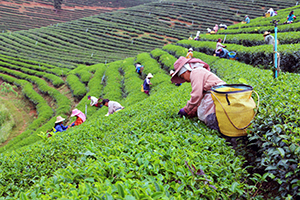
Much of the displaced labor force from urban centers is moving back to rural homes due to closures from restrictions put in place to combat the coronavirus disease (COVID-19). It is important that this displaced labor force is put in a working environment and kept engaged, specifically in the agricultural sector, so that such the young and energetic in the workforce are not left out. A disgruntled labor force without financial support might turn to unwanted or illegal activities. Governments must put in place policies and programs to keep this workforce employed, especially in agriculture, and countries can also use the trained labor force in infrastructure development at the rural level. The provision of government subsidies and the availability of funds to support small-scale farmers and enterprises are key aspects for keeping the national economy growing during these difficult times.
The major economic loss for agricultural production in much of the developing world is due to post-harvest losses. Major losses result from a lack of infrastructure and post-harvest processing machinery support at the rural level. The construction of storage facilities for grains and refrigerated spaces for fruit and vegetables is critical for extending the shelf life of fresh agricultural products. In addition, the implementation of effective and appropriate-scale technologies for drying (e.g., solar-assisted dryers), cooling, and minimal processing will help improve the farming sector. These investments for building infrastructure will keep the displaced labor force active so they can be ready to move back to their urban jobs once the virus crisis has been addressed through treatment options and vaccines. The rural agricultural sector also lacks service facilities for the repair and maintenance of farm equipment. Some of the displaced labor force trained in machine repair could be employed to develop such support service facilities and become involved in training a new workforce at the rural level. The trained labor could then take over the service jobs when the skilled mechanics leave the villages and head back to urban employment.
Research has focused on developing low-cost solar dryers using natural convection currents and biomass-fired forced convection heated air dryers (Kumar et al., 2016). These can be constructed and deployed very easily. In addition to irrigation needs, solar-powered pumps (Adhikari, 2020) can be used to pump water for washing fruit and vegetables. Solar power can also be used to operate low-cost cooling systems (Freeman et al., 2017) (e.g., solar diffusion-absorption refrigeration systems for low-cost solar cooling). Sustainable energy applications (Kaygusuz, 2011) are evolving at a rapid pace, and the adoption of such technologies at the rural level requires not only financial support but also a labor force. In addition, post-harvest losses could be greatly reduced through the appropriate use of storage solutions. Many farmers in developing countries store their grain in the open or in cloth or jute bags that allow insect infestations and result in subsequent losses. The use of hermetically sealed bags (Darko et al., 2018) can extend the storage life of grains by preventing infestations and reducing mold growth. Hermetically sealed bags can also reduce oxygen levels with extended storage and prevent further damage to stored grains. Private and government subsidies have to be made available to make such technologies available and affordable for farmers.
In conclusion, agriculture is the backbone for many developing countries, and governmental policies and programs should facilitate the development of agriculture through building infrastructure. Governments should utilize the labor force that has been displaced during the global pandemic and take advantage of having a highly skilled labor force in rural areas to focus on infrastructure building.
_____
References:
Adhikari, D. 2020. Policy Review and Analysis Promoting Solar-Powered Irrigation in India. IWRA (India) Journal, 9(1): 8–15.
Akoto, E.Y., Y.A.K. Klu, M. Lamptey, J.Y. Asibuo, M. Heflin, R. Phillips, D. Jordan, J. Rhoads, D. Hoisington, and J. Chen. 2018. Solar Drying: A Means of Improving the Quality of Peanuts in Ghana. Peanut Science, 2018 45:1, 56–66.
Darko, C., P. Mallikarjunan, and H. Kaya-Celiker. 2018. Effects of Packaging and Pre-Storage Treatments on Aflatoxin Production in Peanut Storage under Controlled Conditions. J Food Sci Technol 55: 1366–1375.
Freeman, J. A. Najjaran, R. Edwards, M. Reid, R. Hall, A. Ramos, C. N. Markides. 2017. Testing and Simulation of a Solar Diffusion-Absorption Refrigeration System for Low-Cost Solar Cooling in India. Proceedings of IEA SHC International Conference on Solar Heating and Cooling for Buildings and Industry. ISES Solar World Congress 2017, Abu Dhabi, United Arab Emirates, 29 October–2 November 2017.
Kaygusuz, K. 2011. Energy Services and Energy Poverty for Sustainable Rural Development. Renewable and Sustainable Energy Reviews, 15(2): 936–947.
Kumar, M., S.K. Sansaniwal, and P. Khatak. 2016. Progress in Solar Dryers for Drying Various Commodities. Renewable and Sustainable Energy Reviews 55: 346–360.







Comments are closed.